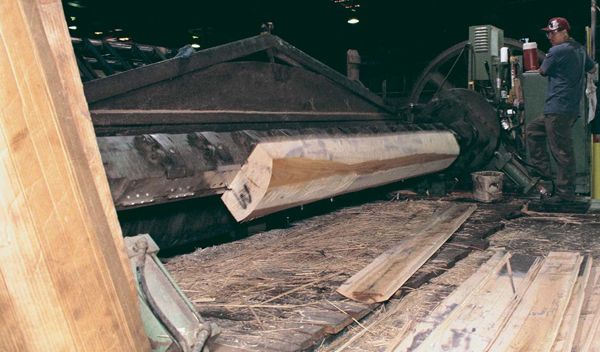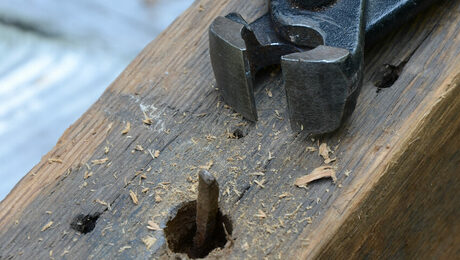
Synopsis: William Duckworth of Fine Woodworking visited three veneer manufacturing plants to see just how veneer is made. He describes the equipment used to cut the burls, and says that plain slicers are commonly used for premium and furniture-grade veneer. The knives used at these plants are awesome – huge, sharp, and frequently honed. Finding veneer-quality logs is an art, he learned, and the factories don’t waste much of them. And for those willing to pay high prices, there are some amazingly beautiful and rare woods to be had.
Walk into the burl warehouse of the M. Bohlke Veneer Corp. in Fairfield, Ohio, and you might be struck with an almost religious reverence for the place. Unlike the other buildings that house this veneer manufacturing operation, this storage building is dead quiet, cool and damp. Burls of amboyna, Carpathian elm, maple, redwood and walnut—some of them as big as 8 ft. in diameter—lie in bunches on the floor like giant mushrooms sprouting from the moist concrete. Owner Manfred Bohlke’s private collection of totem poles, reaching toward the 25-ft. ceilings, stand guard over the harvested burls and add to the cathedral-like effect of this space.
Bohlke joined the ranks of this business 25 years ago when he purchased a small operation called the Fairfield Veneer Mill. Back then, he had a slicer, a drier and only a few employees. Nowadays, he has 13 slicers, nine driers and 350 employees who produce some two million square feet of veneer per day.
The Bohlke Corp. is one of 100 or so manufacturers in the United States and Canada that slices the veneer used for doors, furniture, plywood panels and high-end architectural millwork. The annual production of all the manufacturers in North America works out to many billions of square feet of veneer. Figuring an average tree yields about 7,000 sq. ft. (depending on how thick you slice it), that means somewhere close to a million trees are felled and made into premium-quality veneer every year.
It’s all in how you slice it
Bohlke’s burls set the company apart from some of the other high-end veneer plants that I visited. Because of their odd shapes, burls are best cut on a rotary lathe. Bohlke has four of them. The knife remains fixed, and the burl rotates in a complete arc. The company also has eight plain slicers and one half-round slicer—essential equipment for premium-quality veneer production.
Plain slicers (see the top photo on the facing page), also called flat-cut slicers, accomplish most of the veneer-cutting work at all of the manufacturing plants throughout North America. Plainsliced, book-matched veneer is what you will find on the best plywood panels and the most expensive manufactured furniture.
With both plain slicers and halfround slicers, the flitch is moved against a fixed knife. Plain slicers move the flitch straight up and down at a slight angle left to right, similar to the way you would work a knife against a ripe tomato to get a clean cut. Half-round slicers (see the bottom photo) rotate the flitch in an arc almost parallel to the center of the log, so you get veneer very similar to plain-sliced but with lesspronounced cathedral patterns showing on the face.
From Fine Woodworking #126
For the full article, download the PDF below:
Fine Woodworking Recommended Products

Starrett 12-in. combination square

Ridgid R4331 Planer

AnchorSeal Log and Lumber End-Grain Sealer





















Log in or create an account to post a comment.
Sign up Log in